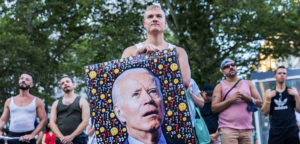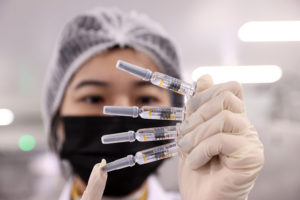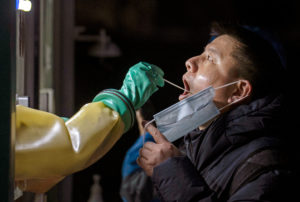Few people in America today are as powerful and polarising as Anthony Fauci. For the Left, Fauci is a consummate cool-headed scientist, emblematic of the essential role of government. On the Right, he is a Deep State operative who destroyed the lives of countless people to serve a hidden agenda, all while mysteriously taking home a bigger paycheck than any other of the country’s two million federal employees (including their collective boss, the President).
The reality is that both narratives fundamentally misunderstand the position Fauci occupies in American government. Far from being a public health expert, Fauci sits at the very top of America’s biodefence infrastructure. And contrary to the notion that he is a Deep State string-puller of the Democratic party, it was George W. Bush and Dick Cheney who not only put Fauci there but created the very framework that the immunologist-physician commands.
This in part accounts for the otherwise inexplicable fact that Fauci, loathed by President Trump, was never fired by the notoriously vengeful politician who galvanised his brand with the phrase “You’re fired!”. But Fauci’s untouchability raises an even more perplexing question: Why did the media beatify him as the country’s beneficent, infallible Covid saviour rather than look into the reality of his position and the source of his nearly limitless authority?
To understand the rise of Fauci, and his legacy as he retires this year, we must return to the first months of the 2000s, when a hawkish new administration was settling into power. While George W. Bush had come to Washington touting a new brand of “compassionate conservatism”, Cheney came carrying decades of Defense Department experience, including a term as Defense Secretary under George H.W. Bush during Operation Desert Storm.
Bush’s interest in biodefence and pandemic preparedness is frequently traced back to a 2004 book, The Great Influenza. The reality, however, is that the administration came to power with biological weapons and infectious disease very much top of mind, with Cheney seeking to address the gaping hole in America’s national security left by the country’s lack of a coherent biodefence strategy.
But if biodefence wasn’t already a priority for the Bush White House, that swiftly changed a week to the day after the 9/11 attacks, a mere eight months into Bush’s first term, when the United States suffered the most serious biological weapons attack in its history. On September 18, 2001, a number of national media outlets, including CBS News, NBC News, ABC News, the New York Post and the National Enquirer, received a series of letters containing a dry white powder. Three weeks later, a second round of letters was sent to the offices of senators Tom Daschle, then the Senate Majority leader, and Patrick Leahy, head of the Senate Judiciary Committee. Twenty-two people were infected with anthrax, five of whom died. Already in a state of unprecedented military alert, the United States was sent into near-chaos by the anthrax attacks, which, by essentially weaponising the postal system with one of the world’s most lethal pathogens, engendered a sense that the country was under attack by an unseen enemy with unfathomable capabilities.
Bush has been rightly credited with identifying the threat of a global pandemic, as well as providing a serious policy for dealing with the spread of HIV/AIDS in Africa. But it was Cheney who served as the political engine behind a paradigm shift that would soon take place in America’s biodefence strategy. Six days before the 9/11 attacks, the Senate Foreign Relations Committee convened a hearing on “The Threat of Bioterrorism and the Spread of Infectious Diseases”. The hearing was led by Joe Biden, then chair of the committee, and included testimony by experts in strategic defence. In a prepared statement, Bill Frist, a physician who served as a Republican senator until 2007, noted that: “Any threat to the security of the United States from a weapon of mass destruction, even those with low probability of occurrence but high potential consequence, including biological weapons, must be taken seriously through adequate preparation.”
The administration’s first landmark achievement in this effort was the creation of a presidential directive called “Biodefense for the 21st Century“. Signed by Bush in April 2004, it advanced a “comprehensive framework for [America’s] biodefence” based on the assumption that a bioweapons attack could devastate America. Despite being premised on a different intent (an attack), the framework described a scenario chillingly similar to what the world experienced with Covid-19, warning that a bioweapons attack could result in “catastrophic numbers of casualties, long-term disease and disability, psychological trauma, and mass panic; disrupt critical sectors of the economy and the day-to-day lives of Americans; and create cascading international effects by disrupting and damaging international trade relationships, potentially globalising the impacts of an attack on United States soil”.
That the directive warned about a biological catastrophe resulting from an attack, rather than an unintentional outbreak, was a seemingly natural assumption in the aftermath of 9/11. But even in June 2001, a small number of senior policymakers spent two days running a simulation of a bioweapons attack. Called Dark Winter, it was designed by the Johns Hopkins Center for Civilian Biodefense Strategies and was based on a putative smallpox attack. Intended less to bolster preparedness than to expose vulnerabilities, the operation showed how quickly a public health disaster could lead to widespread chaos and social collapse. This was the stuff nightmares are made of — and, by all accounts, those were the nightmares that Dick Cheney was having.
Significant as it was, his transformation of America’s biodefence framework was part of a much larger repositioning of long-term geopolitical strategy, an effort also led by Cheney. In the aftermath of the Soviet Union’s collapse in the early Nineties, Cheney, then Secretary of Defense under George H.W. Bush, along with Undersecretary of Defense Paul Wolfowitz, began formulating a grand strategy for the post-Cold War era. This plan, revealed in an infamous leaked memo, was rooted in a single strategic objective: America should permanently remain the world’s superpower. Its architects argued the US would do so only by preserving “strategic depth” to “shape the security environment”. The initial leaked memo was later reworked by Cheney’s chief of staff, Scooter Libby, who broadened the concept of “strategic depth” to cover not only geographic reach but also an ability to wage war with weapons that could not only cripple an enemy’s military capabilities but disrupt its political, economic and social stability.
In this context, the Bush Administration began ramping up biodefence spending, which quintupled to $317 million in 2002 alone. But that same year, an unusual respiratory disease started to spread in the Guangdong region of China. Eventually classified as Severe Acute Respiratory Syndrome, or SARS, the disease would claim the lives of some 800 people as it spread across Asia, Europe, North America, the Mideast, reaching as far as New Zealand.
Although SARS was contained by the summer of 2003, that year the world witnessed the outbreak of yet another respiratory disease. In this case, it was the re-emergence of an avian influenza in the form of a strain known as H5N1, which had long been identified as having pandemic potential. The virus was found to have a terrifying 60% mortality rate.
By 2003, the Bush administration was requesting $2 billion in annual budget for biodefence — a sum that, as the Los Angeles Times noted, exceeded the combined research budgets for breast cancer, lung cancer, stroke and tuberculosis. That year, Bush announced in his State of the Union address that he would propose a further $6 billion for the development and stockpiling of vaccines over the subsequent decade, in addition to baseline biodefence funding.
The money was essential, but transforming a core element of America’s national strategic defence was as much about restructuring the governmental and human aspects of biodefence as it was funding them. In the case of research-based bioweapons preparedness, Cheney’s masterstroke was to remove the fragmented biodefence research programmes from various departments, institutes and centres, and place them under the aegis of a single institute: the National Institute of Allergy and Infectious Diseases (NIAID), led then, as now, by Anthony Fauci.
A 2003 NIAID article detailed what this shift meant for the relatively obscure public health agency: “In 2003, NIAID was assigned lead responsibility… for civilian biodefence research with a focus on research and early development of medical countermeasures against terrorist threats from infections diseases and radiation exposures. NIAID later assumed responsibility for coordinating the NIH-wide effort to develop medical countermeasures against threats to the civilian population.” While the statement is laden with references to “civilian research”, it included a crucial caveat that explains much about its role right through the Covid-19 pandemic: “Because new potentially deadly pathogens, such as avian influenza, may be naturally occurring as well as deliberately introduced by terrorists, NIAID’s biodefence research is integrated into its larger emerging and re-emerging infectious diseases portfolio.”
In other words, as far as NIAID was concerned, there was no meaningful administrative distinction between biodefence and scientific research. With the stroke of Cheney’s pen, all United States biodefence efforts, classified or unclassified, were placed under the aegis of Anthony Fauci. So important was this new command structure that a representative from the office of Scooter Libby, Cheney’s powerful chief of staff, was physically placed in NIAID headquarters in Washington during the transition to function as “a kind of political commissar” from the vice president’s office. This gave Fauci unparalleled access to not just Cheney, but President Bush, to whom he had an open channel.
Fauci now had a virtual carte blanche to not merely approve but design and run the kind of research projects he sought — and could do so with no oversight structure above him. Biodefence projects that formerly would have fallen under the authority of military or intelligence agencies were now under his direct supervision.
It’s this that explains one of the most bewildering irregularities surrounding Anthony Fauci: his compensation. As widely reported, Fauci is the highest paid member of the federal government, out-earning the President, four-star generals, senators, and Super Court Justices. His salary roughly doubled that of his own (nominal) boss, until recently, NIH director Francis Collins. Fauci’s giant pay packet can be traced back to 2004, the year after NIAID was made the country’s top biodefence authority agency. According to a report by Forbes, that year NIH deputy director Raynard S. Kingston wrote a formal memo to the agency’s director, Elias Zerhouni “to request that the current retention allowance [amount redacted] for Dr. Anthony S. Fauci be converted… in order to appropriately compensate him for the level of his responsibly in his current position of Director, National Institute of Allergy and Infectious Diseases (NIAID), National Institutes of Health (NIH), especially as it relates to his work on biodefence research activities.”
This salary jump was only a by-product of the radical restructuring of America’s biodefence apparatus. The much more significant outcome was that Fauci was essentially placed at the top of a new chain of command over which he gained nearly total decision-making ability. He went from being the director of one the NIH’s constituent 27 institutes to being the only one who really mattered.
But it was Fauci’s ability to span the divide between science and politics, to “play ball”, that made him essential to the political echelon. The rapid increase in biodefence funding in the post-9/11 world, and the mushrooming of agencies and departments involved in the endeavour, would inevitably draw critics. One was, and still is, Richard Ebright, a major figure in the world of epidemiology who serves as chair of the Board of Governors and is a Professor of Chemistry and Chemical Biology at Rutgers University.
“This well-intentioned response may perversely have exactly the opposite effect,” Ebright told the Los Angeles Times in 2003, implying that the burgeoning field of biodefence research could lead to leaks, failures, and even a bioweapons arms race. But, by then, the Bush administration had hired a man credible enough to respond to, and, in many ways, outshine the critics. “It’s going to be a challenge,” Fauci told the Times, dismissing Ebright’s concern as “spurious”. “But I have every confidence that the biomedical research community will adapt well to the change.”
Almost two decades later, as he heads towards retirement, his confidence seems misplaced. Perhaps in this we have another crucial lesson from the pandemic: that Marvel-like heroes, with all their fabulous abilities, are no replacement for the facts.
Disclaimer
Some of the posts we share are controversial and we do not necessarily agree with them in the whole extend. Sometimes we agree with the content or part of it but we do not agree with the narration or language. Nevertheless we find them somehow interesting, valuable and/or informative or we share them, because we strongly believe in freedom of speech, free press and journalism. We strongly encourage you to have a critical approach to all the content, do your own research and analysis to build your own opinion.
We would be glad to have your feedback.
Source: UnHerd Read the original article here: https://unherd.com/




